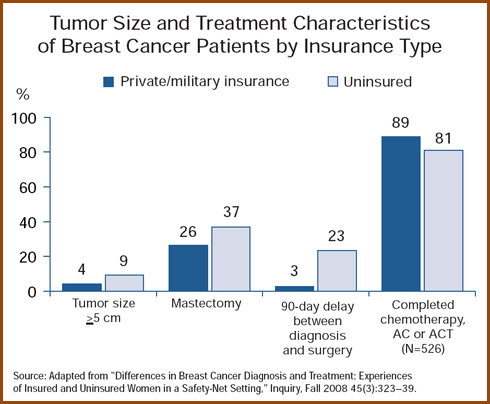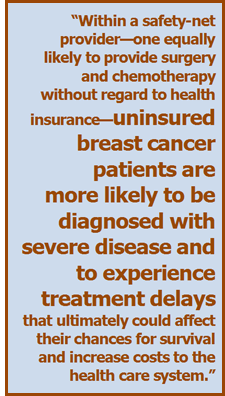An abstract is available at:
http://www.inquiryjournalonline.org/inqronline/?request=get-abstract&issn=0046-9580&volume=045&issue=03&page=0323
Synopsis
Even after controlling for socioeconomic characteristics, uninsured breast cancer patients at a large safety-net hospital system were more likely than their insured counterparts to be diagnosed with advanced disease requiring more extensive and costly treatment. Uninsured women also experienced delays in starting and completing treatment.

The Issue
Lacking universal health coverage, the United States relies on a safety net of hospitals and clinics to treat uninsured patients, including patients with chronic, life-threatening, and costly diseases like breast cancer. This study compared the diagnosis and treatment of insured and uninsured women with breast cancer in an urban safety-net hospital system to explore how well the safety net performs in caring for these two groups.
Key Findings
- Uninsured women were more likely to be black and unmarried, and were more likely to be diagnosed at an advanced cancer state and with larger tumors.
- As expected given the cancer stage and tumor size, uninsured women were more likely than insured women to have a mastectomy (37% versus 26%) and initiate chemotherapy (62% versus 52%)
- Compared with insured women, uninsured women had considerably longer times from diagnosis to surgery and from surgery to chemotherapy initiation—about three weeks longer in both cases. Once chemotherapy was initiated, insured women were more likely to complete the treatment.
- Uninsured women were more likely than their insured counterparts to require a longer, more extensive chemotherapy regimen (50% versus 41%).
Addressing the Problem
 Researchers and policymakers have proposed expanding the safety net as a way to provide access to health care for the uninsured. However, this study’s findings show large differences in the diagnosis and treatment of insured and uninsured breast cancer patients within a safety-net system, which “seem unlikely to be attributable to unmeasured socioeconomic differences between women with and without insurance.” The authors say the evidence suggests that safety-net institutions are only a partial substitute for health insurance and that a more comprehensive alternative is needed for uninsured patients.
Researchers and policymakers have proposed expanding the safety net as a way to provide access to health care for the uninsured. However, this study’s findings show large differences in the diagnosis and treatment of insured and uninsured breast cancer patients within a safety-net system, which “seem unlikely to be attributable to unmeasured socioeconomic differences between women with and without insurance.” The authors say the evidence suggests that safety-net institutions are only a partial substitute for health insurance and that a more comprehensive alternative is needed for uninsured patients.
About the Study
The study evaluated the effect of health insurance on breast cancer diagnosis and treatment at Virginia Commonwealth University Health Care System’s Massey Cancer Center. Data were obtained from the patient registry for all breast cancer patients diagnosed between January 1, 1999, and March 31, 2006, and were merged with the system’s administrative billing system. The resulting sample was 1,334 women, of whom 213 were uninsured.
The Bottom Line
Even after controlling for socioeconomic characteristics, uninsured women with breast cancer are more likely than their insured counterparts to require more costly treatment and are more likely have worse outcomes. The current health care safety net is not a substitute for universal health insurance coverage.


